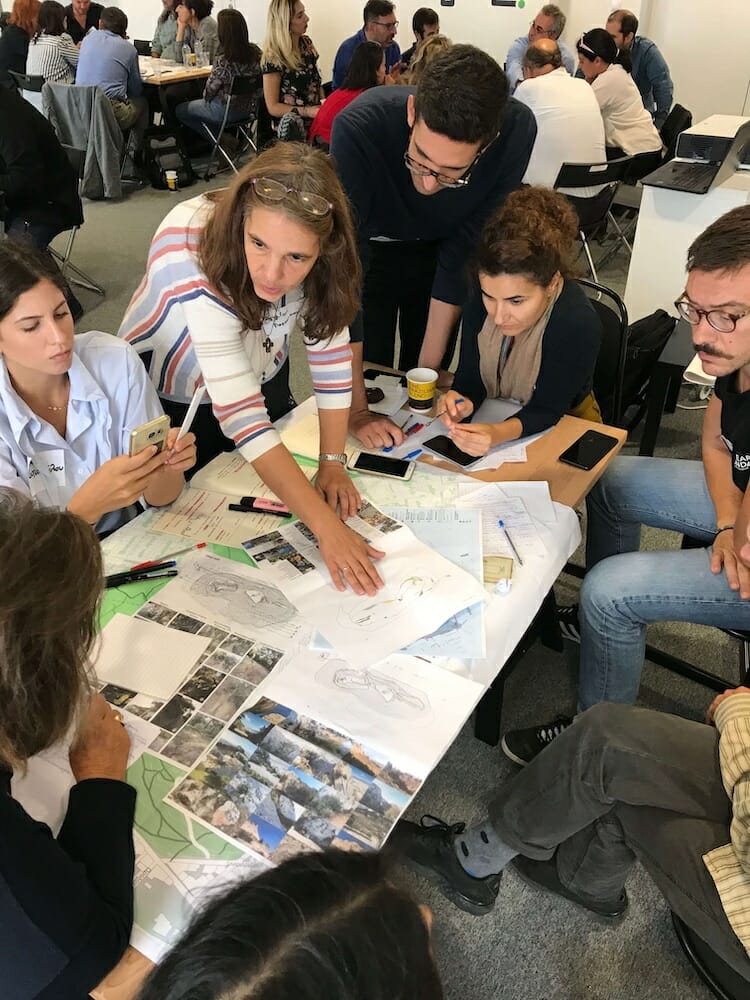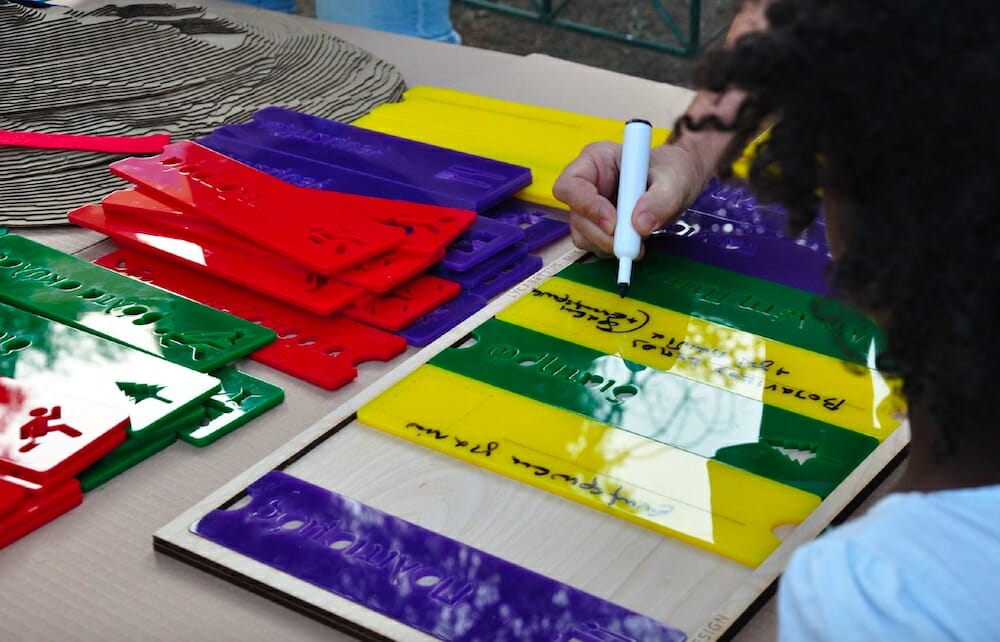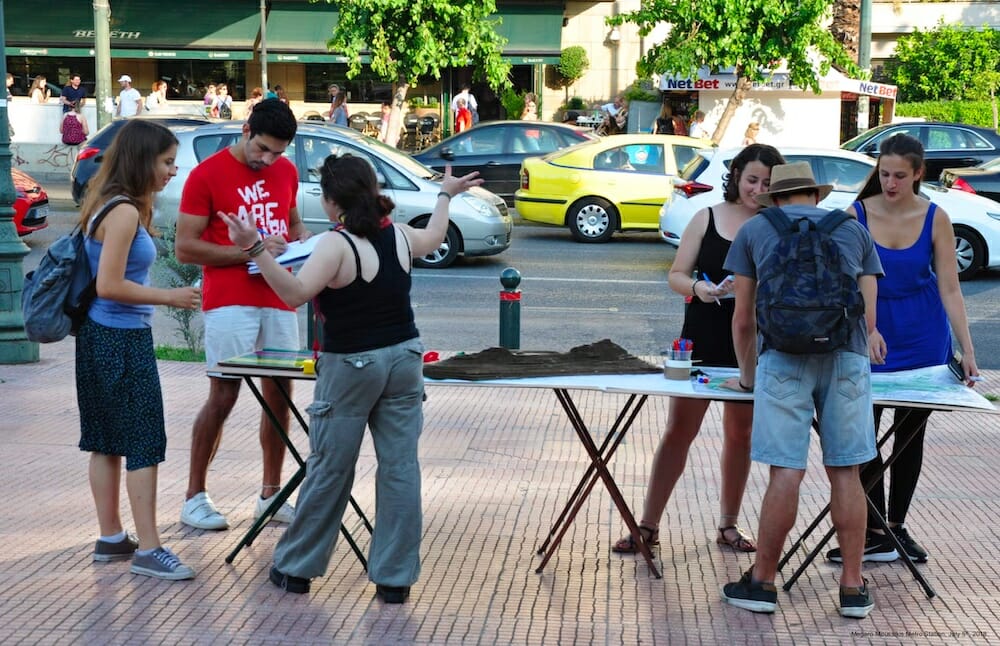Planning with the Public in Greece
Reimagining Lycabettus Hill
Amongst the undulating hills of Athens, Lycabettus Hill stands out as the highest peak. Seen from almost anywhere in the city, the Hill occupies a pivotal position in the urban imaginary of Athenians.

The project team gathers with local residents to plan a better future for a local landmark.
By Idan Sasson and Amy Chester
The massive public green space is used by residents and tourists alike who are looking to enjoy views and escape the hustle of the city. The sheer size, diversity, and unique history of the Hill allow for a wide range of use.
The Hill is perhaps best known for the colorful 3,000-seat amphitheater, designed by renowned Greek architect Takis Zenetos and constructed in the mid-1960s, perched at its peak. The theatre hosted groups and performances ranging from James Brown to Jethro Tull until its closing in 2011. Many residents cherish their memories of sitting at the highest point of the city and listening to their favorite performances with a panoramic view of Athens in the background. Most Athenian adults have at least one significant childhood memory on the Hill. Whether it was a picnic with family, or a hike with a dog, Lycabettus has been a center for public life going back several decades.
“I remember hearing the bands practice up on the Hill while my mother’s friend would cook in their apartment at the base of the Hill. We also used to often walk up to the top and get a stunning view of our city down below,” said Iliana Alexandrou, a local resident.
However, the closing of this beloved venue and years of degradation of the site led many residents to cast aside the central importance and beauty of one of Athens’ largest urban forests.
Since the Greek economic crisis in 2009, Athens has had to weather painful budget cuts, social upheaval, and a decrease in public trust. In the early years of the crisis, the maintenance of many of Athens’s public spaces was neglected in the triage of keeping the city afloat. If you visit the hill today, you will find that paths and lighting are not well-maintained, and soil erosion has led to flooding in a residential area below. Only adventurous tourists do the two-kilometer trek up and back, as there is no wayfinding signage and one can easily get lost. Most tourists take an $8 tram straight to the top, snap a picture of the Parthenon, have a coffee at the cafe, and then come back the same way they went up.
Urban Resilience
Simultaneously, Athens and, more generally, Greece, have seen a boom in tourism that has changed the economic and social landscape. The surge in foreign visitors was a welcome change for the city, allowing planners and residents to start thinking about a future beyond the economic crisis. However, the unprecedented increase in tourism has put added stress on already-present issues in the city, including transportation, environmental degradation, and safety concerns. With this in mind, the city undertook an effort to understand the resilience challenges in the city and identified Lycabettus Hill as a primary site to study the impacts of increased visitors and plan design interventions to address challenges for the site and for the city as a whole.
As Vice Mayor Eleni Myrivilli noted, “Urban resilience is about facing and learning to adapt to hard challenges in ways that look towards the future. It’s about being able to shift our point of view, redefine our goals, and develop skills that make us stronger. It’s really a dynamic transformation. That’s what made a public green space like Lycabettus Hill such an opportune site for collaboration.”
With the onset of a resilience planning framework, the mayor’s administration sought to merge the efforts for this site and go beyond traditional urban green space revitalization. As a central, large, and green public asset, the city was looking for a long-term plan that would address a multitude of current and future challenges. Additionally, the city wanted to use this opportunity to engage residents in planning. Such a process would widen the scope of the project to address social and cultural challenges in the city, while also building the public support needed to implement the vision in the long term.
Rebuild by Design
In order to create an open and transparent planning process that would engage a wide range of residents and stakeholders in the future plan, Rebuild by Design was brought on to the project. Rebuild originated as a design competition after Hurricane Sandy devastated much of the Northeast coast of the United States in 2012, and has since transitioned into an organization that works with cities on inclusive and multidisciplinary planning processes. We developed a methodology for the engagement process that relies on a series of ongoing feedback loops to integrate the input of a wide range of stakeholders and residents.
In each of our engagements at Rebuild, we combined locally-sourced technical expertise with the expertise of citizens. This balance was essential in gaining an understanding of what is needed for the future. Through various activities, events, workshops and meetings, the Lycabettus Hill planning team was able to better prioritize projects, solidify the vision, and gain an understanding of what might be missing from the plan.
To enhance the design process, Rebuild by Design partnered with New Jersey Institute of Technology’s (NJIT) Master of Infrastructure Planning program and Interboro Partners, an architecture firm based in Brooklyn, New York, both led by Georgeen Theodore. Rebuild and Interboro Partners developed engagement activities to be executed by the municipality of Athens that would solicit input from a wide range of stakeholders and residents to create a robust understanding of the general public’s vision for Lycabettus, while also raising awareness and public support for the project. Theodore discussed the philosophy behind this practice, stating that “Way too often, community engagement is thought of as some kind of checklist or a chore, a required task that is completed at the outset of a project. Conversely, in our work, we see community engagement as central to the design process and an activity that happens throughout. We see community engagement as more of a dialogue, where information flows not only from the project team but from the people who live and work in a place.”

Engaging the Public
Engagement tools were designed to solicit input from residents and stakeholders of various backgrounds on what they liked, what they didn’t like, and what they wanted to see in the future of Lycabettus Hill. Tools included digital and analog activities aimed at creatively soliciting citizens thoughts and desires. To spark conversation with residents and utilize the engagement tools, Interboro Partners trained students from local Athenian universities to serve as mobile street teams.
The street teams went to over a dozen locations to engage residents during the summer of 2018, including metro stops, farmers’ markets, and public squares. Working in pairs, one facilitator would engage and converse with the participant while the other would record the interaction, along with name, age, and postal code. A digital survey was created to reach a large number of people and gather basic info that would inform the design process. Participants were given a card with a link to the survey that would ask questions about how they currently use Lycabettus Hill and what ideas they might have for Lycabettus Hill’s future. A paper version of the survey was printed for older participants who were less likely to use a smartphone or another internet-enabled device.
A model of Lycabettus Hill was used to solicit input about outdoor spaces, entranceways, and paths on the Hill. The model was an interactive tool that asked participants to place pieces of colored felt on areas of the Hill that they liked, areas that they felt needed improvement, entrances, and paths that they used, and ideas they had for the Hill’s future. Green felt pieces corresponded to areas that they liked. Red felt pieces corresponded to areas that they did not like. Blue felt pieces indicated new ideas. The mobility of the model allowed it to become a placemaking device where people gathered together, sharing opinions and ideas.
A map of Lycabettus Hill and its surrounding neighborhoods was also used to solicit input about outdoor spaces, entranceways, and paths on the Hill. Using dry erase markers, participants were invited to write, draw, and highlight areas on the Hill using corresponding colors to indicate areas that they liked, areas that they did not like, and areas for which they proposed new ideas.

Photo: Interboro Partners
A game called My Lycabettus was created to playfully solicit participants’ preferred mixture of activity types on the Hill. Without specifying locations, participants placed 10 colored game pieces on a game board indicating their preferred types of activities. Red pieces indicated active recreation, green indicated nature activities, and purple indicated cultural activities. Participants were also given the option to add their own activities on an empty yellow piece. This activity allowed us to gain insight about user interests and enabled us to engage people in the planning of the Hill without having to ask them about specific areas or places. “I’d like balanced and mild uses on the Hill … like outdoor sports equipment and a playground with light impact on the Hill and environment,” shared one neighborhood resident while playing the game.
Overall, the outreach program resulted in over 1,000 digital survey responses in addition to the responses from residents that were engaged in the pop-up mobile engagement stations. By engaging local Athenians through specific activities, the city raised awareness, gathered opinions and data, and formed a group of people interested in helping Lycabettus Hill.


The Plan & The Future
Through public engagement, the surveys, and various workshops, the municipality learned that most residents view Lycabettus Hill as a vital green asset that protects Athens and as a significant landmark for the city. In the words of one workshop participant in reference to the site, “The Acropolis, that’s for the tourists. Lycabettus, that is for us.”
This social process helped the designers and planners for the site gain a thorough understanding of how the public identified with this space and what they’d like to see there in the future. With the long-term vision as a guide, the local universities responsible for planning the site chose and refined short term projects and created the long-term plan.
As noted by Maria Kaltsa, Project Manager for the Lycabettus Hill Program, “The new projects and actions for Lycabettus Hill can now be selected based on a master plan of principles and guidelines that synthesizes the most important desires of residents with all the scientific material, leading to widespread support from the public.”
In September of 2018, the mayor of Athens announced funding for four priority projects: repair of pathways to improve accessibility, water management interventions to address issues of erosion, bioclimatic improvements to the main road, and deep cleaning of vegetation. For the long term, a number of ambitious proposals were put forth to improve accessibility and integration of the Hill with the rest of the city, most notably a call for a cable car to take visitors directly to the top of the Hill. The city is also taking steps to improve the basic maintenance of the ecosystem and infrastructure on the Hill to revitalize the once- lively public green space.
Beyond the proposals themselves, the process was both unique and successful in its multidisciplinary approach. There is little precedent in Athens for collaboration between the local Greek universities and civic leaders on a project at this scale. The partnership between the Agricultural University and the National Technical University brought together experts to design holistic interventions that addressed the ecology of the site as well as the other urban planning and design elements. Additionally, the strong emphasis on widespread community and stakeholder engagement was a shift for traditional Greek planning processes, leading to more refined proposals with stronger support and input from residents.
“The project was challenging and exciting, and has never been attempted in Greece on this scale. No one partner – technical researchers, public administration, or engagement designers – could have achieved this alone. This plan that we are quite proud of was obtained by the combination of these various forces,” said Kaltsa.
The transformation of Lycabettus Hill will undoubtedly take several years, going well beyond the term of the current mayor. However, this process built a strong support network of individuals and institutions that will be necessary in order to realize the Hill’s full potential in the years to come. The continued engagement of these stakeholders and local residents will ensure that Lycabettus Hill becomes a cultural ecosystem and a model of management and civic participation.
